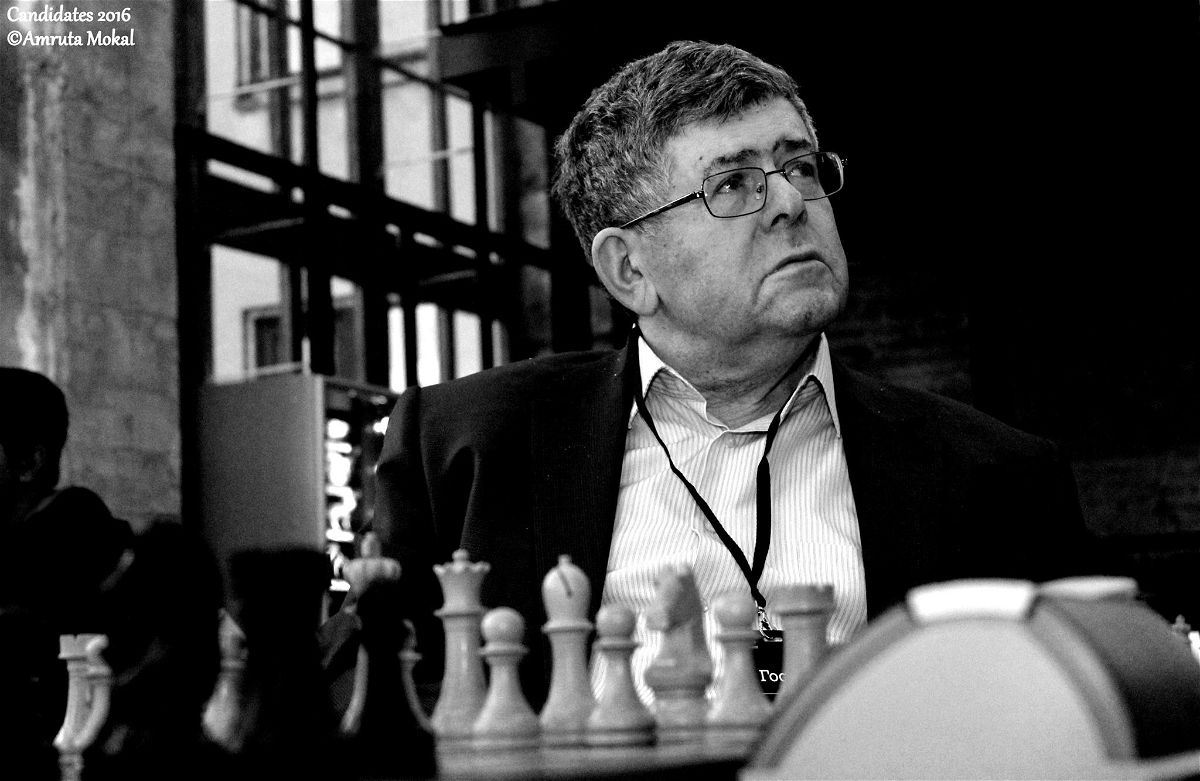Mark Dvoretsky - the greatest chess trainer is no more
The legendary trainer Mark Dvoretsky is no more. He died on 26th of September 2016 at the age of 68 years. Mark had been suffering from ill health from quite some time. However, he had been working on chess right until the very end of his life. He was a true chess lover who spent almost his time helping other players to reach their highest potential in chess. The chess world has lost a visionary and a great human being. Mark is no more but his books and teachings will continue to inspire generations of chess players.

Chess player, Trainer, Author and most of all a great human being. Mark Dvoretsky (1947 - 2016)
Since last three days I have been transcribing the interview of Mark Dvoretsky which I had taken a few months ago. Putting the earphones and writing down each and every word he said was like sitting next to him and listening to him talk. And now I get the news that he is no more. This news is just impossible to digest.
With the death of Mark Izrailevich Dvoretsky, the world of chess has lost a visionary and a great teacher. So many chess players were able to take their game to the next level thanks to his books. It was our great fortune that Amruta and I got to spend nearly four hours with him at his home in Moscow in March 2016.

With Mark Dvoretsky and his wife Inna at their home in Moscow
Listen to Mark giving his opinion on the critical game between Karjakin vs Caruana from the final round of the Candidates 2016
Mark Dvoretsky was the coach of world class players like Artur Yusupov, Alexey Dreev, Sergey Dolmatov, Nana Alexandria. He had also worked with world class players like Anand and Topalov. While only a few have been fortunate to learn from Mark in person, thousands of chess players have benefitted from his books. I do not know of a single player above the rating of 2200 who hasn't touched Dvoretsky's books. Mark is gone but his teachings will live on.

Not many people know that in the seventies Mark Dvoretsky was the strongest IM in the world for many years. He had a rating of 2535 and was ranked 35th in the Elo rating list.
If there is one game of Mark Dvoretsky which sticks to my mind, it has to be his win over former World Champion Vasily Smyslov. In fact Smyslov makes quite a few errors. However, what I liked the most is Dvoretsky's explanation and his incessant urge to find the truth for his opponent's errors. Overall if you go over the game carefully you will realize what a great story-teller Mark was. It's a typical Dvoretsky lesson - It has a story, fun to read, and at the same time you learn a lot about chess!
[Event "URS-ch sf"]
[Site "Odessa"]
[Date "1974.??.??"]
[Round "?"]
[White "Dvoretzky, Mark"]
[Black "Smyslov, Vassily"]
[Result "1-0"]
[ECO "C68"]
[Annotator "Mark Dvoretsky"]
[PlyCount "55"]
[EventDate "1974.??.??"]
[EventType "tourn"]
[EventRounds "17"]
[EventCountry "URS"]
[SourceTitle "EXT 1999"]
[Source "ChessBase"]
[SourceDate "1998.11.10"]
1. e4 e5 2. Nf3 Nc6 3. Bb5 a6 4. Bxc6 dxc6 5. O-O Qe7 {In my preparation I had
reckoned with the possibility of Smyslov choosing this variation. In the
magazine The Chess Player I had found the game Gheorghiu-Smyslov, Interzonal
tournament, Petropolis 1973 in which the former world champion achieved an
excellent position after 6.b3} 6. d4 {This was mentioned by Gheorghiu in the
analysis of his game.} (6. b3 Bg4 7. h3 Bh5 8. Bb2 f6 9. d3 Nh6 10. Nbd2 g5 $1
{Gheorghiu-Smyslov, 1973.}) 6... exd4 7. Qxd4 Bg4 (7... Qf6 8. Qxf6 Nxf6 9. Bf4
$14) 8. Bf4 Bxf3 9. gxf3 Nf6 10. Nc3 Nh5 11. Bg3 Rd8 {Gheorghiu analyzed until
this point and said that this doesn't give White any advantage. But this
assessment seemed dubious to me. After Qe3 the endgame that arises is
favourable for White.} 12. Qe3 (12. Qa4 Nxg3 13. hxg3 Qb4 14. Rad1 Qxa4 15.
Rxd8+ Kxd8 16. Nxa4 g6 17. f4 b5 18. Nc3 Bg7 19. Kg2 ({If} 19. e5 {Smyslov in
his notes gives} f6 20. Rd1+ Kc8 21. e6 f5 22. Rd7 Bxc3 23. bxc3 Re8 $11) 19...
Ke7 $6 (19... Bxc3 20. bxc3 Ke7 $1 {was more accurate according to Smyslov.})
20. e5 Rd8 21. Rd1 Rxd1 22. Nxd1 Ke6 {1/2-1/2 (29) Bednarski,J (2395)-Smyslov,
V (2620) Skopje 1972 Black subsequently gained a draw. (Please check the note
at the end of the game to see how this game against Bednarski was important in
Dvoretsky deciphering Smyslov's play.}) 12... Nxg3 13. hxg3 Qc5 14. Rad1 {
But could such an ending be won against Smyslov? Would not the mass exchanges
made by White be regarded as a desire to avoid a struggle and make a quick
draw? These are doubts typical of a young player. In making my decision I was
helped by master (later a well-known grandmaster) Yuri Razuvaev. "What I would
like to know is in what opening can you hope to gain better winning chances,
than here? And why should it matter who thinks what about it?" he asked.} Qxe3
{In my preparation I had decided to simply recapture the queen. However, on
the board I decided to give two intermediate checks, and perhaps, incorrectly.}
15. Rxd8+ Kxd8 16. Rd1+ {Now Black has to solve two positional problems. The
first is the choice of the pawn structure. If the pawn moving from f2 to e3
does not suit him, he can avoid this by Qd2!? (He would not have had this
resource if White had taken the queen two moves earlier). The second problem
is where to put his king.} Kc8 $2 {A serious positional mistake. The main
events will develop in the centre and on the kingside and it is there that the
king should have been kept. After all in the endgame it should take an active
part in the play.} 17. fxe3 $16 g6 $2 {Another mistake after which Black's
position becomes hopeless. It made sense to put a brake on the e-pawn by f6.
He could have also considered Bc5 Kf2 Rd8, in order, after exchanging the
rooks, to bring the king back into play. However, even then White would have
stood considerably better.} 18. e5 Bg7 (18... Bc5 19. Kf2 Re8 20. f4 f6 21. Ne4
$18) 19. f4 f6 20. exf6 Bxf6 21. e4 h5 22. Kg2 Bxc3 $6 {The exchange of the
bishop makes it easier for White to convert his advantage.} 23. bxc3 b5 24. e5
a5 25. Kh3 $1 {The start of a decisive invasion by the white king. If Black
king were in the centre he would have been able to put up something of a
defence, but now he has no chances. It is useful to note that in the pawn
ending with the given pawn structure, Black is unable to create a passed pawn
on the queenside. After c6-c5 ( with the idea of c4, c7-c5, b4 and a4 etc.)
White replies c3-c4!} b4 26. Kh4 Re8 27. Kg5 Re6 28. Kh6 {There is no defence
against Kg7-f7. There is no defence against Kg7-f7. The chess reasons for
Black's defeat are explained in the notes to this game. The game provides
quite a good textbook example of the role of the king in the endgame. It is
something else that is hard to understand. Why did the former World Champion
Vasily Smyslov, a famed master of the endgame play this endgame so weakly? In
such cases superficial commentators stare at the ceiling, and then fabricate
standard explanations, such as tiredness (however, the game was played in the
first round!), underestimation of the opponent and so on. All this does not
explain anything. I found the reason a few months later when in the 14th
volume of the chess informant I discovered the earlier game Bednarski-Smyslov
Olympiad, Skopje 1972. This game is given in the notes to White's 12th move
above. After studying the game against Bednarski it all becomes clear. In our
game the World Champion followed the plan that he had found and successfully
employed against Bednarski. Alas in the position there was an imperceptible,
but very significant difference: the f2 pawn had moved to e3. As a result all
the ideas (g6, the king move in the variation to c8, and the exchange of
bishop and knight) which there had been appropriate and good, in our game
turned out to be bad, for the reason that after the exchange of the e5 pawn it
was immediately replaced by a new e-pawn, which was now passed. The
conclusions regarding the dangers of routine thinking, and the uncritical
following of familiar patterns, will, I think, be found independently by the
reader.} 1-0
[Site "Odessa"]
[Date "1974.??.??"]
[Round "?"]
[White "Dvoretzky, Mark"]
[Black "Smyslov, Vassily"]
[Result "1-0"]
[ECO "C68"]
[Annotator "Mark Dvoretsky"]
[PlyCount "55"]
[EventDate "1974.??.??"]
[EventType "tourn"]
[EventRounds "17"]
[EventCountry "URS"]
[SourceTitle "EXT 1999"]
[Source "ChessBase"]
[SourceDate "1998.11.10"]
1. e4 e5 2. Nf3 Nc6 3. Bb5 a6 4. Bxc6 dxc6 5. O-O Qe7 {In my preparation I had
reckoned with the possibility of Smyslov choosing this variation. In the
magazine The Chess Player I had found the game Gheorghiu-Smyslov, Interzonal
tournament, Petropolis 1973 in which the former world champion achieved an
excellent position after 6.b3} 6. d4 {This was mentioned by Gheorghiu in the
analysis of his game.} (6. b3 Bg4 7. h3 Bh5 8. Bb2 f6 9. d3 Nh6 10. Nbd2 g5 $1
{Gheorghiu-Smyslov, 1973.}) 6... exd4 7. Qxd4 Bg4 (7... Qf6 8. Qxf6 Nxf6 9. Bf4
$14) 8. Bf4 Bxf3 9. gxf3 Nf6 10. Nc3 Nh5 11. Bg3 Rd8 {Gheorghiu analyzed until
this point and said that this doesn't give White any advantage. But this
assessment seemed dubious to me. After Qe3 the endgame that arises is
favourable for White.} 12. Qe3 (12. Qa4 Nxg3 13. hxg3 Qb4 14. Rad1 Qxa4 15.
Rxd8+ Kxd8 16. Nxa4 g6 17. f4 b5 18. Nc3 Bg7 19. Kg2 ({If} 19. e5 {Smyslov in
his notes gives} f6 20. Rd1+ Kc8 21. e6 f5 22. Rd7 Bxc3 23. bxc3 Re8 $11) 19...
Ke7 $6 (19... Bxc3 20. bxc3 Ke7 $1 {was more accurate according to Smyslov.})
20. e5 Rd8 21. Rd1 Rxd1 22. Nxd1 Ke6 {1/2-1/2 (29) Bednarski,J (2395)-Smyslov,
V (2620) Skopje 1972 Black subsequently gained a draw. (Please check the note
at the end of the game to see how this game against Bednarski was important in
Dvoretsky deciphering Smyslov's play.}) 12... Nxg3 13. hxg3 Qc5 14. Rad1 {
But could such an ending be won against Smyslov? Would not the mass exchanges
made by White be regarded as a desire to avoid a struggle and make a quick
draw? These are doubts typical of a young player. In making my decision I was
helped by master (later a well-known grandmaster) Yuri Razuvaev. "What I would
like to know is in what opening can you hope to gain better winning chances,
than here? And why should it matter who thinks what about it?" he asked.} Qxe3
{In my preparation I had decided to simply recapture the queen. However, on
the board I decided to give two intermediate checks, and perhaps, incorrectly.}
15. Rxd8+ Kxd8 16. Rd1+ {Now Black has to solve two positional problems. The
first is the choice of the pawn structure. If the pawn moving from f2 to e3
does not suit him, he can avoid this by Qd2!? (He would not have had this
resource if White had taken the queen two moves earlier). The second problem
is where to put his king.} Kc8 $2 {A serious positional mistake. The main
events will develop in the centre and on the kingside and it is there that the
king should have been kept. After all in the endgame it should take an active
part in the play.} 17. fxe3 $16 g6 $2 {Another mistake after which Black's
position becomes hopeless. It made sense to put a brake on the e-pawn by f6.
He could have also considered Bc5 Kf2 Rd8, in order, after exchanging the
rooks, to bring the king back into play. However, even then White would have
stood considerably better.} 18. e5 Bg7 (18... Bc5 19. Kf2 Re8 20. f4 f6 21. Ne4
$18) 19. f4 f6 20. exf6 Bxf6 21. e4 h5 22. Kg2 Bxc3 $6 {The exchange of the
bishop makes it easier for White to convert his advantage.} 23. bxc3 b5 24. e5
a5 25. Kh3 $1 {The start of a decisive invasion by the white king. If Black
king were in the centre he would have been able to put up something of a
defence, but now he has no chances. It is useful to note that in the pawn
ending with the given pawn structure, Black is unable to create a passed pawn
on the queenside. After c6-c5 ( with the idea of c4, c7-c5, b4 and a4 etc.)
White replies c3-c4!} b4 26. Kh4 Re8 27. Kg5 Re6 28. Kh6 {There is no defence
against Kg7-f7. There is no defence against Kg7-f7. The chess reasons for
Black's defeat are explained in the notes to this game. The game provides
quite a good textbook example of the role of the king in the endgame. It is
something else that is hard to understand. Why did the former World Champion
Vasily Smyslov, a famed master of the endgame play this endgame so weakly? In
such cases superficial commentators stare at the ceiling, and then fabricate
standard explanations, such as tiredness (however, the game was played in the
first round!), underestimation of the opponent and so on. All this does not
explain anything. I found the reason a few months later when in the 14th
volume of the chess informant I discovered the earlier game Bednarski-Smyslov
Olympiad, Skopje 1972. This game is given in the notes to White's 12th move
above. After studying the game against Bednarski it all becomes clear. In our
game the World Champion followed the plan that he had found and successfully
employed against Bednarski. Alas in the position there was an imperceptible,
but very significant difference: the f2 pawn had moved to e3. As a result all
the ideas (g6, the king move in the variation to c8, and the exchange of
bishop and knight) which there had been appropriate and good, in our game
turned out to be bad, for the reason that after the exchange of the e5 pawn it
was immediately replaced by a new e-pawn, which was now passed. The
conclusions regarding the dangers of routine thinking, and the uncritical
following of familiar patterns, will, I think, be found independently by the
reader.} 1-0
In 2014 when I became an International Master, I wrote an article on my blog about the people behind my IM title. This is what I wrote about Mark Dvoretsky:
"My thinking was heavily word based in chess. I think Mark Dvoretsky changed all of it! Variations here, variations there, variations everywhere! I started to think more in terms of concrete moves than abstract theories.
Mark Dvoretsky's works are really of a high quality and I can recommend his books to people aiming to become an IM or GM.
I have read a lot of things about Dvoretsky as to how his methods are inflexible and he doesn't adapt them to suit the needs of specific students. But whatever it is I am grateful to him for showing me that concrete variations are the blood of chess.
WISH: to have one training session with the man who is deemed as one of the best trainers in the world."
Although I didn't have a training session with Mark, I was able to meet him at his home in 2016 and spend four precious hours interviewing him. Such was his kindness that he and his wife invited Amruta and me to share cake and coffee with them. I will cherish these moments forever. Mark, you will be missed deeply.

